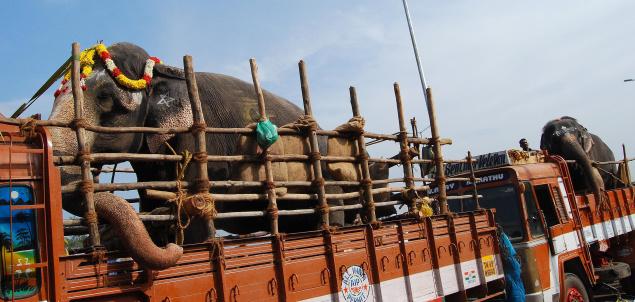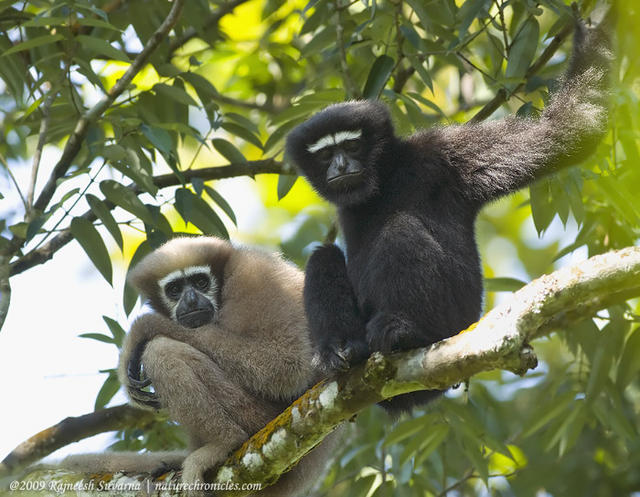13 year old Parvathi, looked quite happy boarding her truck as she looked forward to the 48 day rejuvenation camp planned for her at the cool Madumalai forests. The resident elephant of the famous Meenakshi Sundareswarar Temple will join 34 more temple elephants to roam in the wilderness and relax at the Theppakadu elephant camp […]
Scientists Develop Model to Predict Human-Elephant Conflict Zones
In Indian states like Assam and Kerala where the elephant population of the country is maximum the everyday battles between humans and elephants has become a cause of serious worry. No one can ask the elephants to restrict themselves just to the protected areas of the forest and avoid contact with humans, on the other hand humans too cannot be uprooted from their villages and farms. To ease the tension a team of scientists in Kerala have come up with a prediction model that helps predict possible zones where elephants might tread and come face to face with humans. If the statistical model works, it can be a huge boon in curbing the growing man animal conflicts.
Environment Ministry given Peanuts to Save the Environment
Going green it seems is not an easy task even if you happen to be the Ministry of Environment and Forest. Shockingly, the country is spending only 0.012 per cent of its GDP for addressing its primary green concerns including climate change, conservation of lakes and rivers, biodiversity, forests and wildlife, ensuring the welfare of animals and prevention and abatement of pollution.
Injured Olive Ridley Turtles Saved and Released into the Ocean
A few months back if one looked at the two Olive Ridley Turtles injured on Goa shores by boat propellers, the verdict would definitely have been death. But thanks to the efforts of International Animal Rescue team the turtles could be saved and are now back in the sea waters.
Road Block for Tigers
The tussle between environmentalists and urban developers is in the forefront once again in the state of Maharashtra where the National Highway Authority of India (NHAI) is keen to widen the National Highway NH-6 but the expansion might ruin the forest and crucial corridor of the Tigers.
Forest Department begins Mapping Eco-Sensitive Zones
The areas bordering national parks and reserves are usually rich in natural flora and fauna. The abuse of the biodiversity is also greatest in these areas as they do not fall under any protection frame. But now the forest department is trying to map the land use pattern within a radius of 10 km around national parks so as to protect these biodiversity areas and ecological corridor links.
Hand raised Clouded Leopard and Bear Cubs to Begin New Life in Manas
Two rare clouded leopard cubs and four Asiatic black bear cubs that had been rescued after they were separated from their mothers, are now ready to begin their new life in the jungles of Manas National Park in Assam after having spent quite some time in human company.
Garuda Staging a Comeback
In pages of Indian mythology, the mythical bird Garuda has a pivotal role. Considered as the carrier of Lord Vishnu, this bird is said to have such large wingspan that it can shade the sun. But in the real world, the bird that is biologically known as the Greater Adjuntant and popularly called the Garuda is endangered. Now, Four years after these birds of the stork family started nesting and breeding in Bihar’s Bhagalpur district, their number has increased four-fold – from 78 to over 300.
Good News for Gangetic Dolphin
News of an endangered animal population increasing in number is hard to come by nowadays and therefore whenever such a thing does happen; it brings with itself a sigh of relief. The good news this time is about India’s national aquatic animal the Ganga River Dolphin whose population has increased from 175 last year to 223 at the Vikramshila Gangetic Dolphin Sanctuary, India’s only dolphin sanctuary, located in Bihar.
Sustainability Solutions: Practices for a Better Tomorrow
CII ITC Centre of Excellence for Sustainable Development (CESD) is organising the sixth addition of its sustainability conference. The two day event called Sustainability Solutions: Summit & Exhibition in New Delhi on 25th -26th November, 2011 will explore challenges, opportunities, and strategies for bringing sustainability solutions to Indian Businesses.
Interesting Facts about India’s only Apes: Hoolock Gibbons
India’s biodiversity is home to a varied number of plant and animal species. From the Asiatic Lions inhabiting the semi deciduous forests of western India to the royal Bengal Tigers of Sunderbans, the country has a flora and fauna treasure that is as diverse as the nation itself. But while monkeys and langurs are a common enough site in many Indian states, their cousins, the great man-like apes namely gorillas and orangutans are not found in India. The only tribe of apes inhabiting the country is the Hoolock Gibbons, found in the North-east forests. And because it is the only one, the ape is unquestionably a precious jewel of the Indian forest.










